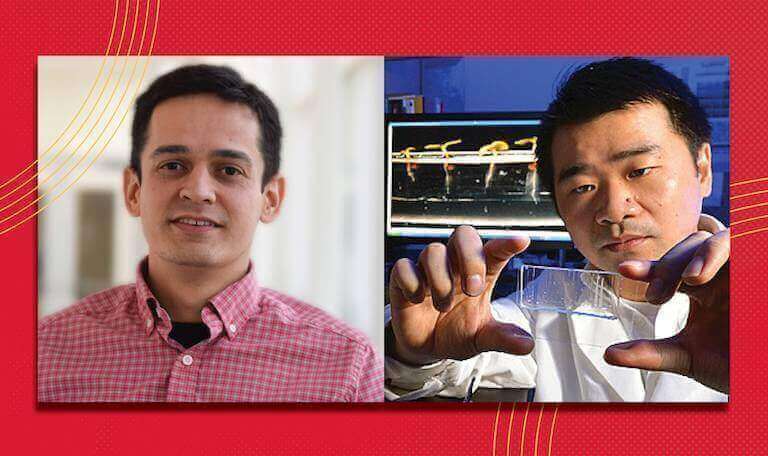Iowa State Awards Research Seed Grants to Two Digital and Precision Agriculture Projects
Posted Jan 22, 2021

Posted Jan 22, 2021

Iowa State University, through the Office of the Vice President for Research, has awarded research seed grants to two Digital and Precision Agriculture-focused projects for the 2021 fiscal year. The seed grants – made possible through funding allocated by the Iowa Legislature – are part of Iowa State’s ongoing support of economic growth in Iowa through innovation and technology transfer in key Bioscience platforms that include Biobased Products and Vaccines and Immunotherapeutics, in addition to Digital and Precision Agriculture.
The seed grants for the Digital and Precision Agriculture platform are similar to those first established and awarded in the other two Bioscience platforms beginning in the 2020 fiscal year. Iowa State purposely structured the seed grants to encourage and facilitate better industry-university collaborations to sharpen focus on research projects that present greater opportunities for commercialization and economic development. Each project selected for funding was required to have an industry partner to help facilitate this path to eventual commercialization.
“The governor and the Iowa Legislature understand the enormous potential the Biosciences hold for growing the state’s economy,” said Iowa State Outgoing Interim Vice President for Research Guru Rao. “This is particularly true in the Digital and Precision Agriculture platform, where new innovations can grow our economy through the industry partners who bring them to market and our farmers who adopt these technologies to increase the efficiency and productivity of the crops and livestock they produce.”
Each seed grant provides a maximum of $50,000 funding, generally over a six-month period. Below are brief overviews of the Digital and Precision Agriculture projects receiving seed grants for FY21:
Project Title: “Forecasting Swine Performance Under Field Conditions in Iowa Based on Ongoing Automated Integration of Data Streams”
Principal Investigator: Daniel Linhares, associate professor, Veterinary Diagnostic and Production Animal Medicine
Industry Partner: Iowa Select Farms
Data from the National Animal Health Monitoring System (NAHMS-USDA) indicate post-weaning mortality rate averages 5% in U.S. swine production systems. This is equivalent to 3.6 million pigs that are not sold to market each year. Post-weaning mortality remains a critical issue largely affected by the interaction of multiple risk factors related to the animals, the production environment, and infectious diseases. The question is, what if we could aggregate and manage the diverse and disperse data generated in pig production systems to create an automated system that would forecast which groups of pigs entering the post-weaning growth phase are more susceptible to disease and other factors that elevate mortality rates?
Daniel Linhares, and his team at Iowa State, have previously developed a prototype methodology to aggregate multi-scale data. That project also proved the concept that drivers of mortality for a given production system can be characterized using a sustainable and consistent platform. The objective of this proposal is to take the next logical step – working with the data provided by Iowa Select Farms (ISF) – to develop a novel automated and ongoing digital platform that provides real-time forecasting information for pigs entering the growing phase.
ISF is the fourth-largest pig-producing operation in the U.S. The company weans approximately 5.5 million piglets each year. A forecasting tool that better predicts and identifies groups of pigs that could benefit most from additional interventions could significantly improve system profitability. For instance, reducing post-weaning mortality by 1% across ISF would result in an additional 66,000 pigs marketed per year, which is equivalent to $2.31 million in profit under current market prices. Additionally, the results from this study will provide a solid foundation for grants from a range for federal funding agencies, including USDA Agriculture Food and Research Initiative (AFRI) and NSF.
Project Title: “Conformal Electrical Property Tomography for Nondestructive, In-Field Measurement of Stalk Integrity”
Principal Investigator: Liang Dong, Northrop Grumman Professor in honor of Fred W. O’Green, Electrical and Computer Engineering
Industry Partner: Corteva Agriscience
Year after year, corn growers across Iowa and around the world are challenged by stock rot diseases and stalk-boring insect infestations that weaken and damage corn stalks, leading to harvesting challenges that ultimately result in reduced yields. Unfortunately, the symptoms stalk-rotting pathogens cause can be misleading, making them difficult to diagnose. Current measurement methods for evaluating the resistance of corn varieties to stalk rots and borers require manual splitting of stalks and visual assessment or measurement of the damage inside. These methods are labor- and time-intensive, provide only qualitative scoring, and result in the destruction of valuable plant materials.
The purpose of this project is to use conformal electrical property tomography technology to develop a non-destructive, highly accurate, high-throughput measurement system to assess corn stalk integrity on a broad scale. Iowa State brings an advanced sensor technology – developed by Liang Dong – to the table while Corteva provides critical industry perspective, expertise, testbeds and integrative skills in stalk integrity management. The uniqueness of this research is the opportunity to develop a first-of-its-kind in-field, low-cost stalk integrity measurement device that can help seed companies evaluate and accelerate the commercialization of new varieties, while providing growers with valuable early – and accurate – detection of disease or insect infestations.
Based on the research results obtained through the grant, Dong and his team anticipate submitting proposals for additional funding to federal agencies such as the U.S. Department of Agriculture (USDA) National Institute of Food and Agriculture (NIFA) and the National Science Foundation.